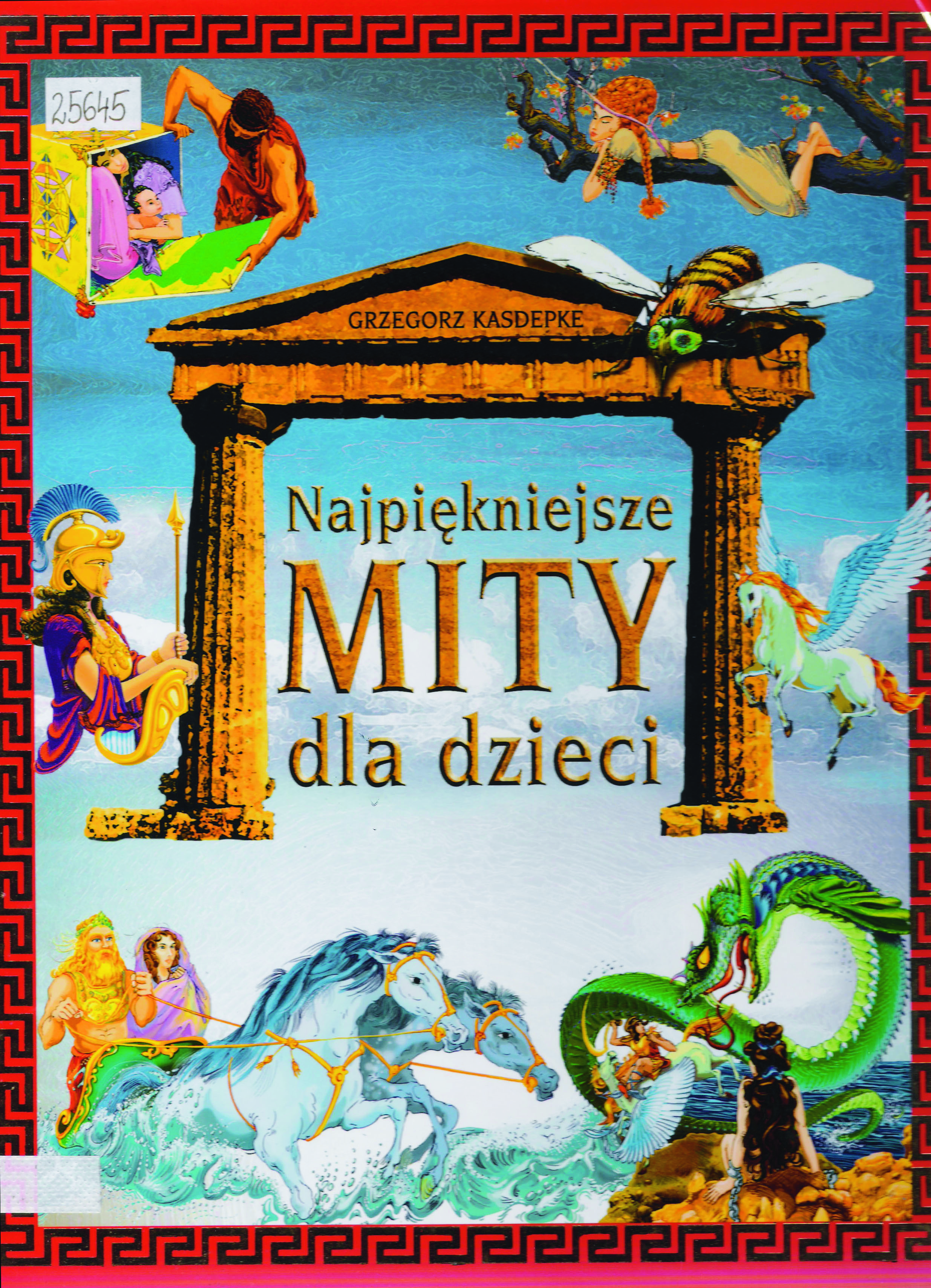Title of the work
Country of the First Edition
Country/countries of popularity
Original Language
First Edition Date
First Edition Details
Grzegorz Kasdepke, Najpiękniejsze mity dla dzieci. Warszawa: Wydawnictwo Wilga, 2004, 56 pp.
ISBN
Genre
Myths
Target Audience
Children
Cover

Scan of the cover kindly provided by Wydawnictwo Wilga.
Author of the Entry:
Marta Pszczolińska, University of Warsaw, m.pszczolinska@al.uw.edu.pl
Peer-reviewer of the Entry:
Katarzyna Marciniak, University of Warsaw, kamar@al.uw.edu.pl
Elżbieta Olechowska, University of Warsaw, elzbieta.olechowska@gmail.com

Photograph by Katarzyna Marcinkiewicz, courtesy of the Author.
Grzegorz Kasdepke
, b. 1972
(Author)
Born in Białystok, now lives in Warsaw. Attended Faculty of Journalism and Political Science at the University of Warsaw. He made his journalistic debut in the weekly “Polityka.” Author of books for children and teenagers, among them many bestsellers. From 1995 to 2000: Editor-in-Chief of the popular magazine for children “Świerszczyk” [The Little Cricket]. Wrote a number of radio-plays for children, as well as scripts for TV programs and series (Ciuchcia [The Choo-Choo Train], Budzik [The Alarm Clock], Podwieczorek u Mini i Maxa [Afternoon Tea at Mini and Max]). Awarded a number of literary prizes. In his books, Kasdepke attempts to explain to his young readers the complicated adult world demonstrating a sense of humour and an understanding of their needs, like for example in books and audiobooks: Co to znaczy... 101 zabawnych historyjek, które pozwolą zrozumieć znaczenie niektórych powiedzeń [What Does It Mean... 101 Funny Stories Helping to Understand the Meaning of Some Expressions], 2002; Bon czy ton. Savoir–vivre dla dzieci [Bon or Ton. Savoir–vivre for Children], 2004; Horror! Skąd się biorą dzieci [Horror! Where Do the Children Come from?], 2009; Kocha, lubi, szanuje, czyli jeszcze o uczuciach [Loves, Likes, Respects, or Again about Feelings], 2012; W moim brzuchu mieszka jakieś zwierzątko [A Little Animal Lives in My Tummy], 2012. He is also the author of crime stories for children – a series of books about Detektyw Pozytywka [Musical Box Detective], 2005–2011. Received the Kornel Makuszyński Prize for his book Kacperiada. Opowiadania dla łobuzów i nie tylko [Kacperiada. Stories for Rogues and not Only], 2001, inspired by his son Kacper. He considers himself “a 100 per cent fairytale writer.” In a recent TV interview the author confirmed the preparation of a new book for children inspired by ancient mythology – Banda trupków i sandały Hermesa [A Gang of Corpsies and Hermes’ Sandals]. Kasdepke wrote about twenty short stories – adaptations of myths, published in five volumes with varying contents, see descriptions below (with a particular stress on the presentation of the most recent volumes). In 2019 he was awarded the Order of the Smile, an international award given by children since 1968.
Bio prepared by Dorota Rejter, University of Warsaw, dorota@bazylczyk.com, and Maria Karpińska, University of Warsaw, mariakarpinska@student.uw.edu.pl

Witold Vargas
, b. 1986
(Illustrator)
Witold Vargas is a writer, storyteller, illustrator, graphic designer and musician born in Bolivia. His parents, Ernesto Vargas and Anna Przerwa-Tetmajer were architects. His most famous and recognizable drawings illustrate bestiaries presenting mythical creatures, especially from Slavic mythologies and folklore. Currently, he is working with Paweł Zych on the series Legendarz [The Legendary], which already includes Bestiariusz słowiański [Slavic Bestiary] in two volumes, which has inspired many creators of the Slavic fantasy genre – writers, storytellers or computer game designers, including the creators of Wiedźmin – Dziki gon [The Witcher – Wild Hunt] RPG.
Sources:
Taniaksiazka (accessed: June 9, 2022).
Sztuka.agraart (accessed: June 9, 2022).
Polawiaczeperel (accessed: June 9, 2022).
Bio prepared by Marta Pszczolińska, University of Warsaw, m.pszczolinska@al.uw.edu.pl
Translation
See the entry Myths for Children.
Sequels, Prequels and Spin-offs
As mentioned at the end of Summary, the same stories in a different sequence were published in Grzegorz Kasdepke, Mity dla dzieci, ill. by Ewa Poklewska-Koziełło, Łódź: Wydawnictwo Literatura, 2009, 104 pp.
Summary
A previous version of the entry was published in: Katarzyna Marciniak, Elżbieta Olechowska, Joanna Kłos, Michał Kucharski (eds.), Polish Literature for Children & Young Adults Inspired by Classical Antiquity: A Catalogue, Faculty of “Artes Liberales”, Warsaw: University of Warsaw, 2013, 444 pp.
Ten myths are preceded by a short preface, in which child readers learn that classical Greek culture lasted 3500 years and ended 1500 years ago. Yet, it has not been forgotten as it still lives in mythological stories, art, architecture, music, and even the language. The stories that Kasdepke tells children are famous myths concerning gods, heroes, nymphs and mortals.
In the order of appearance, the chapters include: Spokojnie, braciszku, spokojnie… [Chill, Bro, Chill…] about the relations between Zeus and Poseidon; Śliczna i mądra – czyli Atena [Lovely and Wise – That Is, Athena], Figlarz [Trickster] about Eros, Doktorze, pomocy! [Doctor, Help!] about Asclepius, Syzyf nie plotkuj [Don’t Gossip, Sisyphus], Głowa Meduzy [Medusa’s Head] about Perseus, Chimera, chi, chi [Chimaera, Ha, Ha] about Bellerophon, Zakaz odwracania się [Do Not Look Back!] about Orpheus and Eurydice, Proszę Pana [Please, Pan], and Tantal, ty okrutniku! [Tantalus, You Cruel Man!]. Kasdepke’s book, “Mity dla dzieci” includes the same stories but in a different sequence. For an analysis, please consult the entry on Mity dla dzieci.
Analysis
For an analysis, please consult the entry on Mity dla dzieci.
Further Reading
Hajduk-Gawron, Wioletta, "Sfera linguakultury jako niezbędny element integracji”, Postscriptum Polonistyczne 2 (2019): 247–258 (accessed: May 7, 2021).
Niesporek-Szamburska, Bernadeta, “Dobre maniery, czyli o dydaktyzmie we współczesnej literaturze dziecięcej” in Bernadeta Niesporek-Szamburska and Małgorzata Wójcik-Dudek, eds. Nowe opisanie świata : literatura i sztuka dla dzieci i młodzieży w kręgach oddziaływań, Katowice: Wydawnictwo Uniwersytetu Śląskiego, 2013, 55–69 (accessed: May 7, 2021).
Plieth-Kalinowska, Izabela, "Świadomość językowa uczniów klas trzecich szkoły podstawowej”, Przegląd Pedagogiczny 1 (2015): 111–118 (accessed: May 7, 2021).


